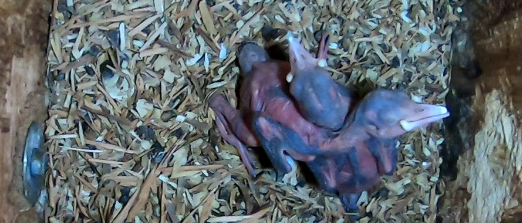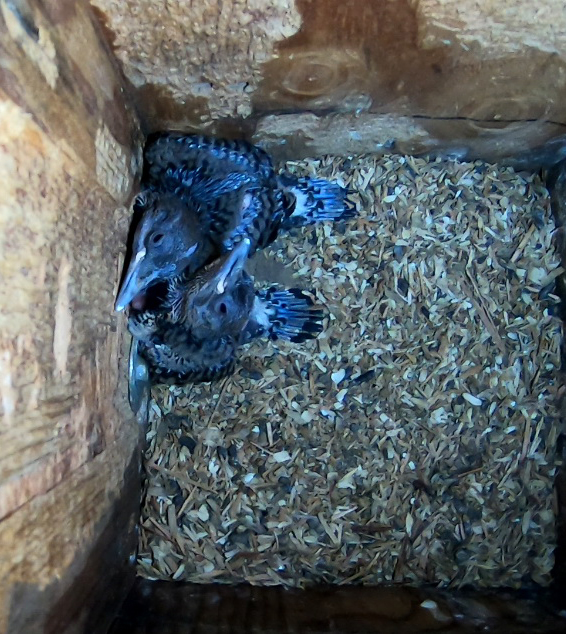 Photo ©
Lee Pauser
Photo ©
Lee Pauser
By Robyn Bailey, NestWatch Project Leader
The young of woodpeckers are notoriously noisy; so much so that you can often find a nest full of young just by following the raucous begging calls to a nearby tree. I have often wondered why this behavior occurs, because if I can find the nest so easily, surely a predator can find them much more readily. This year, and not for the first time, I was able to find a nest of Yellow-bellied Sapsuckers outside my home simply by looking up to locate the source of an incessantly loud noise. How can this be adaptive?

Northern Flicker Nestlings
These two Northern Flicker nestlings look defenseless, but are they?
It seems that Lee Pauser had the same question about some Northern Flickers in his California nest box. Lee wrote to NestWatch observing that the nestlings sounded like a swarm of bees, but he hadn’t seen any documentation confirming this experience. However, there is one reference in the literature to the “nestling buzzing” vocalizations of this species. According to a dissertation written in 1990 by S. Duncan, the nestlings make this buzzing sound when their nest hole is darkened, as when a parent returns to feed them, or if a predator happens to appear in the nest entrance. The buzzing chorus has a frequency and energy spectrum that is said to be similar to a swarm of agitated honey bees (Duncan 1990). Now I haven’t been particularly inspired to get close to a swarm of agitated honey bees, so I will have to take Duncan’s word on this. To my ear, the nestlings do sound like insects, but perhaps more like cicadas than bees.
Listen in on this video captured by Lee Pauser on May 27, 2019.
Do you hear bees? Or just hungry birds? Keep in mind that Lee’s box only has two nestlings in it, whereas the more typical 6-7 young would likely be more convincing. If Duncan’s hypothesis is correct, this could be a form of mimicry that may be intended to convince would-be predators that the nest hole is actually full of noxious honey bees. Similarly, some species of harmless snakes will rattle their tails vigorously to convince predators that they are, in fact, rattlesnakes (check out this milk snake doing its best rattlesnake impression). The key is that the mimicry must be convincing in order to work, but it need not be perfect.
Have a listen to this colony of honey bees, recorded in Ontario in 1958.
And here are the flickers again on June 3, 2019, still buzzing away.
This mimetic behavior is poorly studied, and I am unaware of any other species which might produce a similar sound. It’s possible that Gilded Flickers also have this vocalization. Until 1995, they were considered to be the same species as Northern Flicker. However, I was unable to find any media or literature that referred exclusively to this Sonoran Desert species after it was split from Northern Flicker. If you have media of this species, we would love to accept it!
What do you think? Would these nestlings stop you in your tracks? Or do you know your birds from your bees?
Reference
- Duncan, S. 1990. Auditory communication in breeding Northern Flickers (Colaptes auratus). Ph.D. diss., University of Wisconsin, Milwaukee.
Very cool hypothesis!! I appreciate this type of article. Food for thought.
Do birds hear sounds the same way as humans do?
Hi Alexandria, This is a really interesting question and holds great relevance to the conversation. Birds hear different frequencies of sounds than humans but it does depend on the species. Here is an interesting article that may help explain more. It would be interesting to compare the sound of bees to the sound of these nestlings after removing the frequencies that predator species cannot hear.
I had 5 in my tree last year and just thought that that is what flicker babies sound like!!
I have 7 eggs this year (we cleaned the nest out last fall) and I can take and send a recording if you would like?!
Hi Caroline, If you’d like to share photos or videos with us, please feel free to do so via our photo gallery. Note that in order to share a video, it must first be hosted on a website such as YouTube or Vimeo.
Very interesting! To me, especially in the first recording they sound more like baby goats then bees! I can imagine though that with more birds in the nest the sound could be quite intimidating to predators.
Jennifer, they do sound rather like baby goats, don’t they! I was able to find this additional recording of 4 nestlings in a nest box. https://macaulaylibrary.org/asset/534491. Note that the recordist says they sound like rattlesnakes! As someone who has formerly studied rattlesnakes, I don’t think they’re at all similar, but that’s an interesting hypothesis as well!
This was fascinating! Perhaps with more nestlings and heard from just outside the cavity they might sound more like bees. The sounds resonating through the wood may change the perception of their sounds. (??)
Interesting thought, Joni. Woodpeckers are excellent at amplifying their own sounds by drumming on resonant surfaces (e.g., dead trees, drain pipes). It’s a good question, but I am not sure of the answer.
Wow! Birds are crafty little creatures!
I build a birdhouse for a Souther Crested Flycatcher. Just went to clean the nest out and I’m hearing a faint buzzing inside. My thought it this must be a pest of some sort and not a bird. The birdhouse is filled to the top with nesting so I can’t see what is making the sound.